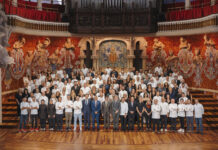Many wine professionals believe that the size and shape of a glass affects a wine’s flavor, but none can quite explain how. Those who ventured a guess during these interviews inevitably invoked the tongue map, that age-old diagram that carves the tongue into tasting zones: sweet in the front, bitter in the back, salty and sour on the sides. One sommelier even suggested that glasses could influence a wine’s flavor by directing it to a particular part of the palate.
The problem with that logic is that the tongue map is complete bunk.
“There is no tongue map for the human,” asserts Dr. Linda Bartoshuk, a sensory scientist at the University of Florida. “The tongue map as we know it originated from a 1940s mistranslation of a 1901 German study.” Though later translations corrected the error, the map has proved a particularly sticky form of pseudoscience, and it continues to be taught to wine students. Dr. Bartoshuk’s lab has studied taste on different tongue areas and concluded that, contrary to popular belief, “you can taste all four basic tastes everywhere there are taste buds. Some variation may occur, but it’s trivial. There was never any empirical data for a tongue map.”
So, if the map is out, then how exactly does the tongue work? According to Dr. Bartoshuk, the surface of the tongue is underlain by a handful of nerves. These nerves transmit sensory information from the taste buds to different parts of the brain; inside the brain, those areas then send inhibitory messages to each other. “It’s like an engineering circuit,” she explains. “It’s a compensatory mechanism to preserve whole mouth taste if you injure your tongue.” That is, when a nerve in the mouth is damaged, tasting capability will not be affected. While the sensory input from that nerve may be lost, its inhibitory effect on the other nerves has also been lost.
By extension, taste can be enhanced by isolating certain parts of the tongue. “Take a strong salt solution. If you dabbed it on the tip of your tongue, it would taste really salty,” says Dr. Bartoshuk, “but if you take a sip and swallow, it appears far less salty than you might have predicted. That’s because when you only stimulate one part of the tongue, you skip the inhibition phase.” While Dr. Bartoshuk admits that she hasn’t yet studied how this phenomenon might relate to wine, she imagines that an expert taster could glean a lot of information by sequestering wine to one part of their mouth and then comparing it to the whole tongue taste.
Dr. Bartoshuk allows that the shape of a glass could potentially influence taste by stimulating just a small area of the tongue, but certainly not by aiming for the “sweet center” of the tongue map, as some in the business have implied. Furthermore, as flavor is the combination of taste plus smell, a glass’s effect on aromatics must also be considered. “Sweet, salty, sour, bitter have relatively little to do with wine,” contends Dr. Bartoshuk. “Most wine tasting is the perception of volatiles. It’s olfaction.”
Scientist and wine writer Dr. Jamie Goode agrees. “The tongue is pretty important for flavor perception for a number of reasons, not the least touch. But we give it too much credit. We think the tongue is detecting a wine’s qualities, but that’s because we localize the sensation of flavor to our mouths. But really, it’s the smell, especially the retronasal smell, that matters.”
The classic do-it-yourself experiment to prove smell’s essential role in flavor is to hold your nose while drinking. Even a casual taster will note the wine’s flavor is considerably muted. But release the nose after swallowing and the flavor will improve. This is because of retronasal olfaction, which happens when a wine’s volatile vapors enter the nose from inside the back of the mouth. “The way you sip, breathe out or in, slurp—all of these things affect the retronasal olfaction,” claims Dr. Bartoshuk.
Orthonasal olfaction, or sniffing, happens via the nostrils. And this is what is most affected by the shape of a wine glass. As Émile Peynaud states in The Taste of Wine, “The relationship of surface area to volume of wine varies according to the shape of the glass and so, consequently, do the phenomena of evaporation, surface tension, and capillarity.” In other words, the wider the bowl, the more volatile aromas are released. In addition, the height of the bowl matters as it determines how close the drinker’s nose is to the wine, and the width of the opening relative to the width of the bowl affects the concentration of volatile compounds. A wide bowl topped by a narrow opening, as in a classic Burgundy glass, would serve to intensify the typically delicate aromas of Pinot Noir, whereas a variety like Cabernet Sauvignon, with its more assertive bouquet, seems to perform better with a wider opening.
In an interesting addendum, Dr. Bartoshuk’s research indicates that, while the smell doesn’t affect a food or drink’s chemical composition (sweet, salty, bitter, sour), it can influence the way those tastes are perceived by the brain. For example, a wine with an abundance of fruity esters may seem to taste sweeter than it actually is. Once again, scientific evidence seems to highlight the primacy of smell over taste as pertains to wine flavor.
Dr. Goode believes that wine professionals process sensory inputs differently than a casual consumer. “Normally, when people smell and taste, it results in one seamless sensation of flavor. But what we do as professionals is different; we try to deconstruct a wine into its elements. And when we do that, we might be changing our own perception as well, in interesting ways.” He goes on to comment, “And because the perception of flavor is created in the brain, you can’t take psychology out of the equation.”
Psychology seems to play an especially important role when it comes to the physical properties of a drinking vessel—how heavy, light, thick, or thin the glass. Even the scientifically rigorous Émile Peynaud believed that the thickness of glass only matters in terms of psychological conditioning. “The rim of a glass (the edge in contact with one’s lips) should be thin, something only possible with crystal. The feeling of thickness does actually influence our impression of what we drink, and we have developed certain preferences in this respect. We prefer beer in a heavy tankard, and while an earthenware mug is all right for a long morning coffee, fine porcelain is preferred for a mocha or an espresso. Ask a taster to try the same wine in two different glasses, one light and fine, the other thick and heavy, and there’s a fair chance he will prefer the wine in the first glass.”
















![Jeff Caruso of Wrapbook Leads the AFM 2025 Film Finance Conversation: Where Capital Meets Creativity [Exclusive Interview] Jeff Caruso of Wrapbook Leads the AFM 2025](https://dailyovation.com/wp-content/uploads/2025/11/Screenshot-2025-11-08-at-5.34.28 PM-218x150.jpg)



![Steve Schapiro: Being Everywhere Documentary Brings Iconic Photographer’s Life to the Big Screen [TRAILER] Steve Schapiro: Being Everywhere Documentary](https://dailyovation.com/wp-content/uploads/2025/09/Screenshot-2025-09-25-at-10.45.21 AM-218x150.jpg)







![Jeff Caruso of Wrapbook Leads the AFM 2025 Film Finance Conversation: Where Capital Meets Creativity [Exclusive Interview] Jeff Caruso of Wrapbook Leads the AFM 2025](https://dailyovation.com/wp-content/uploads/2025/11/Screenshot-2025-11-08-at-5.34.28 PM-100x70.jpg)





Wow! Incredibly informative article! Thank you. I enjoy wine, but I am definitely not an expert. Learning more about the glasses and how it affects the experience is very intriguing.